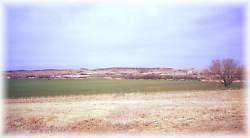Horseshoe Hills
category : Landmarks
 This landmark is a unique formation of hills creating a natural horseshoe shape. Custer and his men camped there the night before the attack on Chief Black Kettle, serving as an ideal place to hide Custer's movements and to scout the sleeping village. These hills also served as an observation post for both the Indians coming to Black Kettle's aid and the 7th Calvary.
This landmark is a unique formation of hills creating a natural horseshoe shape. Custer and his men camped there the night before the attack on Chief Black Kettle, serving as an ideal place to hide Custer's movements and to scout the sleeping village. These hills also served as an observation post for both the Indians coming to Black Kettle's aid and the 7th Calvary.The hills were formed as a result of erosion of the surrounding softer material about 250 million years ago, leaving the harder Doxey Shale behind.
The hills can be observed at a distance while visiting the Washita Battlefield National Historic Site.
Address: 1 mile north of Cheyenne on US283
Come visit us in Cheyenne, Oklahoma
